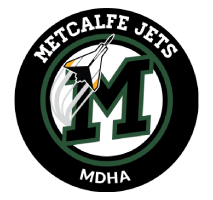WHAT DO I WEAR FOR HOCKEY?
Equipment Required – For All Levels / Divisions
While on the ice, all players and goalies must wear full, properly fitted protective equipment that conforms to the Hockey Canada and the C.S.A. guidelines.
What you need:
- HELMET – must be CSA certified with CSA certified face guard/mask correctly installed. The inside padding must not be brittle or loose from the shell. Should fit snug – not too loose or too tight. Helmets with loose and missing screws, cracks, decals and stickers not affixed by the manufacturer may void the CSA certification and are therefore prohibited/will not pass CSA inspection. DO NOT REMOVE ANY MANUFACTURERS STICKERS. The chin strap is to be fitted snugly under the chin.
- THROAT PROTETOR – must be BNQ certified (have a BNQ stamp)
- SKATES – blades sharp, don’t wrap laces around the ankles.
- SHIN PADS – must be long enough to cover from top of skate to bottom of pants. The skate tongue should be tucked UNDER the shin pad.
- SOCKS AND GARTER BELT – (belt is optional) – socks should extend from top of skate to top of leg, not major rips/tears. Game socks (home and away colours) will be sold by the MDHA.
- PANTS – long enough to meet top of shin pad and high enough for kidney pad to protect kidneys. All padding must be in place.
- ATHLETIC SUPPORTER – Jock strap for boys, Jill strap for girls. Must be worn at all times on the ice.
- SHOULDER PADS/EBLOW PADS/GLOVES or CHEST PROTECTOR – there should be continuous protection down the arm from the shoulder pad to the elbow pad to the glove with minimal or no gaps. Elbow pads should fit tightly enough that they resist sliding out of position when pulled or pushed along the length of the arm – should meet the bottom of the shoulder pad and wrist area of glove. The chest protector should cover the heart area/sternum and be made of rigid or semi-rigid material.
- GLOVES – no holes.
- PRACTICE JERSEY – large enough to extend over the top of pants and elbow pads, not tucked in. (game jerseys are supplied by the association, and are returned at the end of the season.) Practice jerseys are supplied by individual player families.
- STICK – typically should come up to the players chin, while wearing skates. Tape should be wrapped around the blade and the butt end of the stick (sufficient to prevent the butt end of the stick form fitting through a face mask). No cracking or splintering. End cap on composite sticks in place.
- MOUTHGUARD – not mandatory but highly recommended. Ensure proper fit for comfort to the player.
Note for Goaltenders:
For those buying any goalie equipment, it must conform to the latest rules for goaltender equipment
Note: Helmets, stickers, and poor fit are the most common causes of equipment check failures. The adhesive used on non-manufacturer stickers applied to helmets may not meet the helmet manufacturer’s standards, rendering the CSA certification and manufacturer warranties void. Remove them but leave the original manufacturer stickers in place. Check carefully for missing or loose screws and ensure the “J” clips (on the top left and right where the face mask attaches to the helmet) are in place and functional (clips onto face guard and shock absorbs when guard is pushed upward against helmet). If buying a pre-packaged set of ice-hockey equipment for a younger player, you may find some of the items fit, but others do not. Ask the vendor to let you check the quality and fit of each individual piece before you buy. Road/street hockey gear is not an acceptable substitute for ice hockey gear.
Hockey gear should always be hung up to air dry and washed regularly. This practice prolongs the life of the gear and reduces the risk of contracting a nasty bacterial infection. Note: shin pads and gloves are two of the worst offenders when it comes to infection-causing equipment. Please take care of your gear and enjoy another greats season of hockey!


